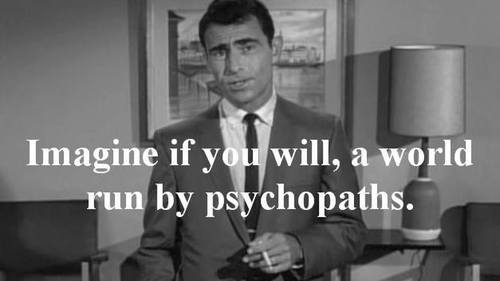Ocasio Cortez Is Correct, There Are American Concentration Camps-3 Studies Demonstrate the Growing Nazi Mentality In the US (Pt 2)

Ocasio Cortez claims there are Concentration on American soil. She is correct! However, the modern day concentration camps are not as she describes and they will not be holding illegal immigrants as she claims. This article is conclusive in the notion that FEMA camps and all that this means will be in our future unless we change course, quickly.

There are FEMA camps. In Part 3 of this series, I will be introducing two public examples of FEMA camps presently in play inside of America. There are 800 FEMA facilities in all. Many do not believe that America will never have the Nazi version of the holocaust. Not only is it possible, it is almost guaranteed if the radicalized liberals takeover the White House in 2020. The following will make it clear how the present climate more than supports this claim. In addition, three psychological studies will be presented to show just how vulnerable any people, not just Americans, are with regard to carrying out genocide against their own people.
Please keep these figures in mind (67% would commit homicide and 60% would knowingly give wrong answers because the group did) as you process the following scenario as covered in three psychological studies.
- The Milgram Study
- The Solomon Asch Experiment
- The Zimbardo Prison Study
What if there was real pressure to perform an act or to express a false belief? How many people would betray their own values and give into the authority figures of the day. Also, keep in mind that Hitler did not begin the Holocaust by immediately murdering millions of Jews. He first chastised them. Then he systematically began to deny employment in one area, university education, then it spread to the banks, then it was all employment, followed by gun confiscation, loss of rights, incarceration and extermination. Today, we see the Big Tech companies carrying out the work of the early Nazis, particularly the social credit system being enacted by Google. The psyops directed at getting America to accept the mark of the beast has reached employment. Americans are being told that if they do not take vaccines, they will lose their children and they will not keep their jobs. This is teaching the public that you cannot resist the will of the real power behind the government. If the government, using the Milgram principle, can get 65% of the people to murder for no reason with minimal pressure, what will the rate of compliance be when there is real pressure? The loss of job threat will likely push these numbers into the 90th percentile. What if one day, it is not the flu vaccine, but rather, the mark of the beast, what will the compliance rate be? No wonder the Bible says very few will ever make it into heaven. Finally, do you ever get a feeling in your heart, and without any proof that something you suspect is indeed true.
Conformity to Group Norms: The Solomon Asch Experiment
Do you think of yourself as a conformist or a non-conformist? If you ask most people the same question, you would find that most people consider themselves to be a non-conformist and would be able to stand up to a group when they know they are right. However, can nonconformists actually resist the peer pressure to blend in with the rest of their peers? In the 1950's, Polish born psychologist, Solomon Asch, conducted a conformity study. The participants signed up to participate in a psychology experiment in which they are asked to complete a vision test. This was a deception. The real experiment attempted to answer the question, can people resist peer pressure to conform to a false belief? Seated in a room with the other participants, the research participants are shown a line segment and then asked to choose the matching line from a group with three segments of different lengths. The experimenter subsequently asked each participant individually to select the matching line segment. On some occasions everyone in the group chooses the correct line, but occasionally, the other participants unanimously declare that a different line is actually the correct match. Unknown to the main subject of the experiment, everyone else in the experiment is a confederate and their answers have been preplanned for the purpose of determining whether, or not, the participant's answer can be determined by the people deliberately giving the wrong answer. Nearly 75 percent of the participants in the conformity experiments went along with the rest of the group at least one time. After combining the trials, the results indicated that participants conformed to the incorrect group answer approximately one-third of the time. At the conclusion of the experiments, participants were asked why they had gone along with the rest of the group. In most cases, the students stated that while they knew the rest of the group was wrong, they did not want to risk facing personal criticism. A few of the participants were so weak-minded that they suggested that they actually believed the other members of the group were correct in their answers. These results suggest that conformity can be influenced both by a need to fit in and a belief that other people are smarter or better informed. Given the level of conformity seen in Asch's experiments, conformity can be even stronger in real-life situations where stimuli are more ambiguous or more difficult to judge. For example, a soldier, in attempting to decide if they will fire upon innocent civilians, will be forced to weigh their own risk. If they fail to obey the command to fire upon American citizens, will they face disciplinary action, or even death? Asch also found that having one of the confederates give the correct answer while the rest of the confederates gave the incorrect answer dramatically lowered conformity. In this situation, just five to ten percent resisted.
.
The Milgram Experiment and Group Think
The world of psychological research provides the definitive answer as to whether we should fear our military in the coming storm ahead in the form of a phenomenon called group think. Group think is often described as a decision-making process whereby the group members go along with what they believe is the consensus. Group think has also been used to describe individual acquiescence to authority even when the authority has limited power to enforce compliance. Group think often causes groups to make hasty, irrational decisions, where individual doubts are set aside, for fear of upsetting the group’s leadership and balance. Just how far will people go to please authority figures and subsequently do what they know to be immoral? The first known laboratory test for groupthink occurred in 1963 by Yale professor, Stanley Milgram. Subjects for this landmark study were recruited for the Yale study through newspaper ads and direct mail. The participants were men between the ages of 20 and 50, from all educational backgrounds, ranging from an elementary school dropout to participants with doctoral degrees. Milgram wanted to determine what percentage of people would willingly administer enough progressive electric shocks which would result in death simply based on the orders of a perceived authority figure (i.e., the experimenter).
There were three participants in the experiment:
1. The Teacher was the real subject in the experiment. Their role was to administer shocks for each wrong answer provided by the learner. How far would they go, was the true subject of the experiment. Would they actually kill a person for failing to provide the correct answer on a word pair test? Would they mindlessly follow the orders of the experimenter to continue with the abuse, regardless of the results and obvious harm being perpetrated upon the pretend victim in the experiment? 2. The second participant, the Learner, was actually a plant in the experiment. The Learner would sit in an adjacent room and pretend to be shocked for each wrong answer that they would purposely give. Eventually, they would cry out for help and beg the Teacher to stop administering the electric shocks. Their cries included pleas of mercy that were often based on an unknown level of self-expressed cardiac distress that they were pretending to experience. 3. The Experimenter was a stern looking fellow who carried a clipboard, wore a lab coat, and would urge the Teacher to continue regardless of the make believe pleas of the Learner. The “Teachers” were told by the experimenter that they would be participating in an experiment to test the effects of punishment on learning. However, as has already been stated, this was not the goal of the experiment. The “Teacher” was given a list of word pairs which was used to teach the Learner. The Learner was actually a confederate, or a plant, in the experiment. The Teacher would then read the first word of each pair and read four possible answers. The Learner would deliberately press the wrong button to indicate his response. Since the answer was incorrect, the Learner would receive an electric shock, with the voltage progressively increasing with each wrong answer. Therefore, the subjects believed that for each wrong answer, the Learner was receiving an ever increasing level of actual shocks which would eventually result in death. In reality, there were no shocks. After the confederate (i.e., Learner) was separated from the subject, the confederate set up a tape recorder integrated with the electro-shock generator, which played pre-recorded sounds of pain and distress for each successive level of shock. After a number of voltage level increases, the Learner would bang on the wall which divided him from the subject (teacher). After several instances of banging on the wall and complaining about his heart condition, the learner provided no further responses to questions and no further complaints. The fate of the Learner was left to the imagination of the teacher. The silence was met with the command to continue with the experiment. Although the Learner was not being harmed, the Teacher believed that they were administering progressively dangerous shocks. From the instrumentation panel, the Teacher could clearly see that their shocks were approaching the level of lethality. Was the Teacher being forced to capitulate and continue with the experiment? Quite the contrary was true, the prompts to continue administering shock were encouraged by minimal prompts and absolutely no threats were offered by the Experimenter.
If at any time the subject hesitated or expressed a desire to discontinue the experiment, the subject was given a planned and verbatim succession of verbal prompts by the experimenter:
1. “Please continue.”
2. “The experiment requires that you continue.”
3. “It is absolutely essential that you continue. ”
4. “You have no other choice, you must go on.”
If the Teacher still wished to stop after having listened to four successive verbal prompts, the experiment was discontinued. Otherwise, the experiment was terminated after the subject had administered the lethal 450-volt shock three times in succession. Milgram expected that less than one percent would actually administer a fatal electric shock. The actual results were so stunning that he decided to film the results on the final day, fearing that nobody would believe his results. And what were the results? Despite expressing some measure of discomfort and the minimal use pressure, in Milgram’s first set of experiments, 65% (26 out of 40) of the subjects administered the experiment’s final and hypothetically fatal 450-volt shock. Amazingly, no participant steadfastly refused to give further shocks before the 300-volt level!
Milgram’s results were confirmed when Dr. Thomas Blass performed a meta-analysis on the results of repeated performances of the experiment. Blass found that the percentage of participants who were willing to administer fatal voltages remains remarkably constant, between 61% and 66%.
The results of Milgram’s and Blass’ work are stunning in their final conclusion which demonstrated that almost two-thirds of all Americans will mindlessly follow the commands of a “perceived” authority figure even when the authority figure has no real power over the people. Can you imagine how the 65% rate will dramatically climb when they authority figure had "real" power over the people being ordered to fire upon American citizens?
The Zimbardo Prison Study
In 1971, psychologist Philip Zimbardo and his colleagues set out to create an experiment that looked at the impact of becoming a prisoner or prison guard. Zimbardo, a former classmate of Stanley Milgram was interested in expanding upon Milgram's research. He wanted to further investigate the impact of situational variables on human behavior. The research question the researchers asked was how would the participants react when placed in a simulated prison environment? Zimbardo had previously speculated that, "Suppose you had only kids who were normally healthy, psychologically and physically, and they knew they would be going into a prison-like environment and that some of their civil rights would be sacrificed. Would those good people, put in that bad, evil place, or, would their goodness triumph?"
The results of the experiment haunt many of us in the psychology field, today, as we ponder how far would Americans go in the enforcement of a brutal and vicious tyranny? Zimbardo set up a mock prison in the basement of Stanford University's psychology building, and then selected 24 undergraduate students to play the roles of both prisoners and guards. The assignment of roles was accomplished through random selection. The participants were selected because they had no criminal background, lacked psychological issues and had no major medical conditions. Therefore, the participants in the study were far more psychologically and physically healthy than any group of modern day military force, police force or FEMA camp guards. The volunteers agreed to participate for a one- to two-week period. Prisoners were to remain in the mock prison 24-hours a day for the duration of the study. Guards, on the other hand, were assigned to work in three-man teams for eight-hour shifts. After each shift, guards were allowed to return to their homes until their next shift. Researchers were able to observe the behavior of the prisoners and guards through the use of hidden cameras.
The experiment was originally scheduled to last two weeks, but it had to be stopped after just six days due to what was happening to the student participants. The guards became exceptionally abusive and the prisoners began to show signs of extreme stress, anxiety and nervous breakdown. The prisoners and guards were allowed to behave in any manner they chose. However, the interactions were generally hostile or even dehumanizing. The guards began behaving in an aggressive and abusive manner toward the mock prisoners. Subsequently, nearly all of the prisoners became passive and depressed. Five of the prisoners began to experience such severe and acute anxiety, that they had to be released from the study early. Zimbardo later wrote in his book The Lucifer Effect that "Only a few people were able to resist the situational temptations to yield to power and dominance while maintaining some semblance of morality and decency; obviously I was not among that noble class" . Even Zimbardo lost his objectivity and the experiment was only halted when his girl friend at the time, Christina Maslach, a graduate psychology student, voiced objections and threatened to break off her relationship with Zimbardo if the experiment continued.
The Stanford Prison Experiment demonstrates the powerful role that the situation can play in human behavior. Because the guards were placed in a position of power, they began to behave in ways they would not normally act in their everyday lives or in other situations. By putting a prison guard uniform on the participants, issuing sun glasses and a baton made the participant guards act in accordance with their perceived role. This has dire consequences for the ability of uniformed personnel to resist orders from their commanding officers to fire upon American citizens. People will act according to the role that they have been assigned to play. Finally, based upon the Zimbardo Prison Experiment, what kind of treatment could you expect at a FEMA camp?
Conclusion
Please use the search engine of this website and search the term FM 39.4, the official document which demonstrates the existence of FEMA camps. FEMA Camps=Genocide, every single time.
In America, there is something called a CMU which is short for Communications Management Unit.These are FEMA Camps for political prisoners who have been incarcerated for exercising their 1st Amendment rights. You will not believe what you are about to read in Part 3. However, the documentation is air tight. There are FEMA camps and many of your alternative media figures are headed towards them, and many of you will be there guests as well, unless we change course.




























Comments
FEMA CAMP. FT. STEWART, GA.
Comment
Many concentration camps are in the US and they are for us.
Comment
OAC is Correct. There are American Concentration Camps
Comment
"There are FEMA camps" Yes…
Comment